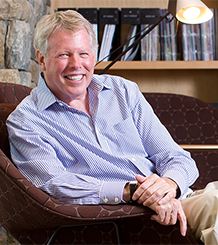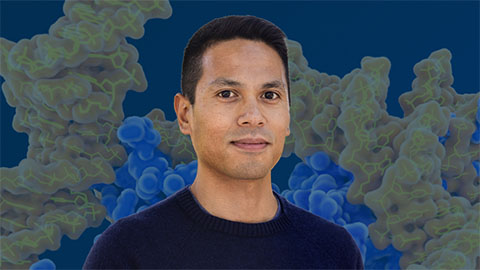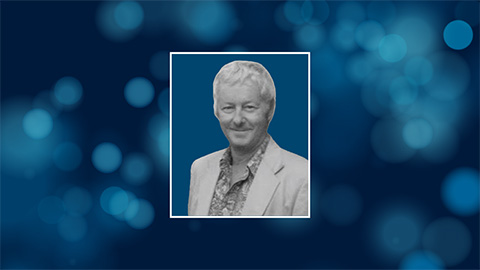Dixon recognized for his research and leadership
Jack E. Dixon at the University of California, San Diego, won the Earl and Thressa Stadtman Distinguished Scientist Award from the American Society for Biochemistry and Molecular Biology in recognition of his work on eukaryotic signal transduction and, in particular, reversible phosphorylation.
Dixon has made several seminal contributions toward understanding enzymes that remove phosphate from proteins (phosphatases) through his work characterizing several members of the protein-tyrosine phosphatases, or PTPases, superfamily.
 "I am extremely pleased about this honor. Earl and Thressa were role models for me when I was a young scientist. I had the pleasure of knowing them and interacting with them over a number of years. They also trained so many outstanding people. It is just great to be a small part of their legacy. " — JACK E DIXON
"I am extremely pleased about this honor. Earl and Thressa were role models for me when I was a young scientist. I had the pleasure of knowing them and interacting with them over a number of years. They also trained so many outstanding people. It is just great to be a small part of their legacy. " — JACK E DIXON “His scientific achievements are outstanding, and he continues to be a powerful advocate for excellence in biochemical and biomedical research,” Minor J. Coon, professor emeritus at the University of Michigan Medical School, wrote in his nomination letter.
Dixon was born in Nashville and received his B.A. in zoology from University of California, Los Angeles, in 1966. He went on to earn his Ph.D. in chemistry from University of California, Santa Barbara, in 1971. He completed his postdoctoral training in biochemistry as a National Science Foundation postdoctoral fellow in the laboratory of Nathan O. Kaplan at UCSD. He then began his career as a faculty member at Purdue University, where he discovered the first dual-specificity phosphatase VH1, encoded by Vaccinia virus. He also showed that the virulence plasmid of Yersinia pestis produces the most active PTPase ever described, in that it drastically affects the host’s immune defenses and results in the pathogenicity of these bacteria.
With these key discoveries, Dixon quickly established himself as an expert in the field. He went on to define several members of this new family of phosphatases and discovered a novel mechanism of their catalytic action. His work is considered to have, as Coon said, “radically advanced the molecular basis of pathogenesis.”
Among Dixon’s recent notable discoveries are the identification of PTEN tumor suppressor as a phosphoinositide phosphate and myotubularin — a protein mutated in muscle myopathies. He also has identified novel covalent post-translational modifications, such as hydroxylation, and O-linked glycosylation of peptide hormones. His laboratory continues to pursue key questions on cell growth and differentiation through a comprehensive study of PTPases.
Scientists mentored by Dixon describe him as a supportive, approachable and encouraging adviser who allows his trainees to develop their projects with freedom while still giving them the requisite guidance and advice. They speak of his investment in their careers and his honest, enthusiastic and collaborative attitude toward scientific discovery.
“I am indebted to Jack for so much of my professional development,” wrote David Pagliarini, assistant professor at the University of Wisconsin, Madison. “The guidance and mentorship I received from him have truly shaped me as a scientist.”
During his tenure as vice-president and chief scientific officer at the Howard Hughes Medical Institute, Dixon was instrumental in developing programs that support young scientists and establishing the open-access policy that allows the work of HHMI researchers to be shared with the scientific community. The HHMI Early Career Scientist Program, the Hughes Collaborative Innovation Awards and a collaboration with the Gordon and Betty Moore Foundation for plant science research are examples of innovative programs developed under Dixon’s leadership to support scientists and their career paths.
In addition to his role at HHMI, Dixon has served as the president of the ASBMB and is a member of the National Academy of Sciences, the American Association for the Advancement of Science and the Institute of Medicine. He is a foreign member of the Royal Society. He has received several awards and fellowships in recognition of his contributions to the research enterprise, including two previous awards from the ASBMB, the William C. Rose Award in 2003 and the ASBMB-Merck Award in 2005.
Earl and Thressa Stadtman, after whom Dixon’s latest ASBMB award is named, were outstanding biochemists and mentors. According to a historical exhibit dedicated to the two scientists at the National Institutes of Health, their laboratories conducted research held to the highest standard of scientific rigor while also fostering a congenial environment for training and mentoring future scientists. The Stadtmans were known to credit junior scientists generously for their ideas and results on publications. Colleagues came to refer to this model of scientific research as “the Stadtman way.” The ASBMB established the award in their names to preserve their legacy and honor basic research scientists who exemplify those qualities.
Earl Stadtman once said: “Productive laboratories are not merely the reflection of good scientific discipline and expert direction but depend almost as much on the establishment of a congenial atmosphere in which science can flourish as a consequence of free thought, unguarded exchange of ideas, critical discussion and a respectful interaction among all of its personnel.”
Enjoy reading ASBMB Today?
Become a member to receive the print edition four times a year and the digital edition monthly.
Learn moreGet the latest from ASBMB Today
Enter your email address, and we’ll send you a weekly email with recent articles, interviews and more.
Latest in People
People highlights or most popular articles

Exploring the link between lipids and longevity
Meng Wang will present her work on metabolism and aging at the ASBMB Annual Meeting, March 7-10, just outside of Washington, D.C.

Defining a ‘crucial gatekeeper’ of lipid metabolism
George Carman receives the Herbert Tabor Research Award at the ASBMB Annual Meeting, March 7–10, just outside of Washington, D.C.

Nuñez receives Vallee Scholar Award
He will receive $400,000 to support his research.

Mydy named Purdue assistant professor
Her lab will focus on protein structure and function, enzyme mechanisms and plant natural product biosynthesis, working to characterize and engineer plant natural products for therapeutic and agricultural applications.

In memoriam: Michael J. Chamberlin
He discovered RNA polymerase and was an ASBMB member for nearly 60 years.

Building the blueprint to block HIV
Wesley Sundquist will present his work on the HIV capsid and revolutionary drug, Lenacapavir, at the ASBMB Annual Meeting, March 7–10, in Maryland.

